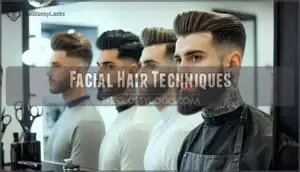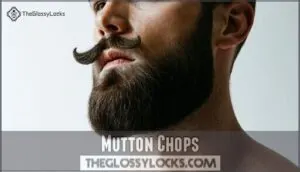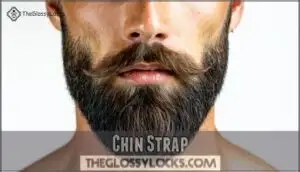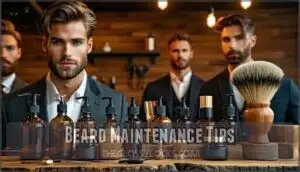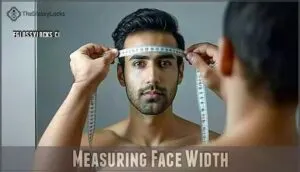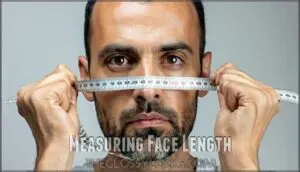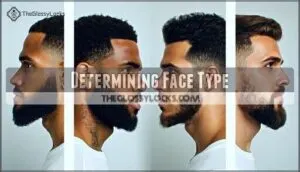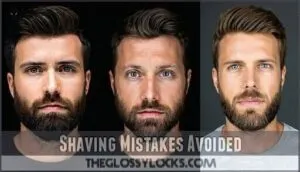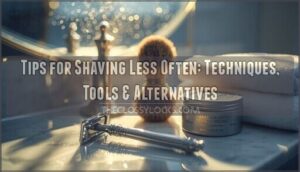This site is supported by our readers. We may earn a commission, at no cost to you, if you purchase through links.
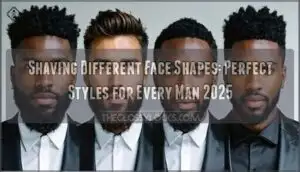
When shaving different face shapes, you’re basically using facial hair as a sculptor’s tool to create balance and proportion.
Oval faces work with nearly any style, while round faces need angular cuts like goatees to add definition.
Square faces benefit from softer, rounded beard styles that complement their strong jawlines, and rectangular faces require width-adding styles like mutton chops or fuller sideburns to balance their length.
The secret lies in identifying your face shape through simple measurements, then selecting styles that either add structure where needed or soften prominent areas to achieve strategic enhancement and master the fundamentals of grooming.
Table Of Contents
- Key Takeaways
- Shaving Face Shapes
- Beard Styles Guide
- Facial Hair Techniques
- Rectangular Face Shapes
- Beard Maintenance Tips
- Face Shape Identification
- Shaving Mistakes Avoided
- Frequently Asked Questions (FAQs)
- What are the best beard styles for square face shapes?
- How do you style a face shape?
- What is the best face shape?
- Are You navigating the landscape of shaving styles?
- How do I Shave my Face?
- How do you style a square face with a beard?
- Which face shape is good for a clean shave?
- Can you have two different face shapes?
- How to cut hair for different face shapes?
- How to choose beard styles for different face types?
- Conclusion
Key Takeaways
- Identify your face shape first – You will need to measure your forehead width, cheekbone width, jawline width, and face length to determine if you are oval, round, square, or rectangular, since each shape requires different beard styles for optimal balance.
- Match beard styles to your specific face shape – You will enhance round faces with angular cuts like goatees, soften square faces with rounded styles like circle beards, add width to rectangular faces with mutton chops, and leverage oval faces’ versatility with nearly any style.
- Use strategic trimming techniques – You will create better facial proportions by establishing proper necklines with the two-finger rule, maintaining clean edges with quality tools, and following multi-pass shaving methods that work with your hair growth patterns.
- Avoid common shaping mistakes – You will prevent unflattering results by not copying celebrity styles blindly, avoiding over-trimming key areas, and ensuring you are not choosing beard lengths that emphasize your face’s less favorable proportions.
Shaving Face Shapes
Your face shape determines which shaving and beard styles will enhance your natural features most effectively.
Understanding your specific facial structure helps you choose techniques that create balance and highlight your best angles, which is crucial for making informed decisions about your appearance, and ultimately, your natural features.
Oval Face Shapes
You’ve got the golden ticket with an oval face shape – it’s naturally balanced and works with nearly any beard style.
Oval faces are nature’s perfect canvas – every beard style becomes your signature look.
Your face symmetry gives you freedom to experiment with everything from a classic oval beard to bold statement pieces.
Focus on maintaining your natural facial balance rather than trying to reshape your jawline.
Since your cheek definition and facial contours are already well-proportioned, you can enhance rather than correct.
This face shape guide puts you in the driver’s seat for shaving techniques and styling choices.
Round Face Shapes
Managing round faces requires strategic facial hair placement to create the illusion of length and definition. Your goal is achieving better face symmetry through smart jawline trimming and cheek definition techniques.
Focus on adding vertical lines while minimizing width – this means keeping sides shorter and allowing downward growth. Hair texture affects your beard contour, so work with your natural patterns.
Unlike oval faces, round faces need structured shaving techniques that emphasize facial contours and create angular elements. To enhance your look, consider learning about beard style options that can help create a more defined jawline and balanced facial structure.
Square Face Shapes
Square faces pack serious geometric power with that strong, angular jawline and equal width measurements.
You’ll want to soften those sharp edges while maintaining your natural chin definition. Square beards work magic here, creating facial symmetry by adding length below the jaw.
Focus your jawline trimming on the sides rather than underneath. Angular styles need balance – let your facial hair grow downward to elongate your face shape.
Smart razor selection matters for precision work around those defined corners, ensuring you can effectively soften the edges while maintaining the natural contours of your face.
Beard Styles Guide
You’ll discover the most popular beard styles that work with different face shapes, from the classic circle beard to the distinguished royale style.
Each option offers unique ways to enhance your facial features while maintaining a polished, professional appearance.
Circle Beard
With its circular connection between mustache and chin hair, the circle beard creates a refined frame around your mouth.
This versatile facial hair style works exceptionally well for oval and round face shapes, offering professional appeal with manageable maintenance.
You’ll need 2-4 weeks of growth before initial shaping, then regular trimming every 1-2 weeks to maintain those clean, symmetrical edges.
To achieve a well-defined circle beard, consider learning about beard growth tips to optimize your styling routine.
Royale Beard
The Royale Beard elevates your facial hair game with sophisticated styling that commands attention.
This distinguished look features a mustache connected to a pointed chin strap, plus a small patch beneath your bottom lip.
You’ll master this beard style by keeping precise lines and maintaining the signature pointed shape. Regular trimming guarantees your Royale Beard stays sharp and professional-looking.
Goatee Beard
The goatee stands as one of the most versatile beard styles, incorporating facial hair on your chin without extending to the cheeks.
This classic look offers multiple variations, from the petite goatee that helps elongate your chin to fuller styles that create definition.
When trimming your goatee, maintain your mustache’s natural width and follow the hair strip connecting it to your beard for clean lines.
Perfect your shaving technique by rounding the jaw and creating a small "U" shape under your chin using two fingers as your guide to achieve a more defined look.
Facial Hair Techniques
Mastering the right techniques transforms your grooming routine from guesswork into precision.
You’ll discover trimming methods that create clean lines, shaving approaches that complement your face shape, and maintenance tips that keep your facial hair looking sharp between visits to the barber.
Trimming Methods
Master your trimming game with precision and confidence. Start with the neckline – imagine a "U" connecting your ears above the Adam’s apple. Use two fingers to mark this critical boundary.
Your two-finger neckline guide creates perfect boundaries every time.
Quality Trimming Tools make all the difference in achieving professional results. Investing in proper trimming equipment can substantially enhance your trimming experience.
Essential Trimming Methods:
- Fade Techniques: Use guards at half your beard length, trimming inward progressively
- Beard Shaping: Create clean lines following your natural jawline structure
- Edge Control: Maintain sharp boundaries with precise, slow movements
- Hair Texturing: Pick and comb between trims for even distribution
Shaving Methods
Your shave technique determines your results.
Multi-pass shaving—with the grain, across, then against—delivers maximum closeness while reducing irritation.
Map your hair growth patterns first.
Quality shaving creams and proper razor selection protect sensitive skin.
Change blades regularly for peak performance.
Hot towel treatments soften stubborn hair.
Adjust blade angle around facial contours.
Proper aftercare tips prevent razor burn and maintain healthy skin.
Understanding various hair removal methods is essential for achieving the best shaving results.
Maintenance Tips
Keep your grooming tools sharp and clean for peak performance.
Regular beard trimming prevents split ends and maintains your desired shape.
Practice proper shave prep with warm water and quality products to protect your skin.
Establish a consistent shaving frequency based on your skin type and hair growth rate.
Face mapping helps identify problem areas requiring extra attention during maintenance routines, which is crucial for peak performance and overall skin type.
Rectangular Face Shapes
If you have a rectangular face shape, you’re working with angular features that need the right balance to create visual harmony.
Strategic beard styling can add width to your lower face while softening those strong jawlines that define your facial structure.
Mutton Chops
Mutton chops transform your rectangular face by adding width to your jawline while maintaining that strong, masculine edge.
You’ll start with a full beard, then shape thick sideburns extending to your mouth corners.
These bold sideburn styles create visual balance against your face’s length, while regular hair trimming keeps the design sharp.
Shaving your chin area emphasizes the distinctive mutton chop silhouette that complements rectangular facial hair patterns perfectly.
Chin Strap
A chin strap creates a clean facial hair border that frames your rectangular face perfectly.
This beard style circles from ear to ear along your jawline, excluding the mustache area.
You’ll trim everything above the strap line while maintaining a consistent width around your chin.
The defined edge emphasizes your strong jaw structure without adding bulk to your face’s length.
Regular beard trimming keeps the strap sharp and professional-looking.
Gunslinger Beard
Channel your inner cowboy with this iconic gunslinger beard that perfectly complements rectangular face shapes.
This bold combination features flared sideburns paired with a horseshoe mustache, creating that authentic Western vibe.
Use your beard trimmer to maintain clean lines while shaping the distinctive horseshoe pattern. Regular beard trimming keeps this cowboy look sharp and well-defined for maximum impact.
Beard Maintenance Tips
You’ll maintain your perfectly shaped beard by staying consistent with your grooming routine and using the right products.
Regular trimming every 2-3 weeks keeps your style sharp, while quality beard oil prevents dryness and maintains that healthy shine you’re after.
Regular Trimming
Regular trimming forms the backbone of any successful beard maintenance routine, regardless of your face shape.
You’ll want to establish a consistent schedule – typically every 2-3 weeks for most facial hair types. Start with longer guard settings and work your way down gradually.
This prevents over-trimming disasters that’ll leave you waiting months for recovery. Quality trimming tools make all the difference in achieving clean, even results that enhance your chosen style.
Using the right beard trimmers is essential for a polished look.
Beard Oil Usage
Your beard thrives with proper nourishment—beard oil is your secret weapon for healthier facial hair.
Apply 2-6 drops daily after showering, massaging into skin beneath your beard first, then distributing through hair.
This prevents dryness, reduces itchiness, and keeps your beard soft and manageable.
Choose oils based on your skin type for maximum results.
Understanding beard oil techniques is essential for maximizing the benefits of beard oil and maintaining a healthy beard.
Combining Styles
You’ll master Beard Blending by mixing techniques that complement your face shapes.
Experiment with Style Mixing – combine stubble with defined mustache lines, or blend Hair Textures using different guard lengths.
Facial Harmony emerges when you pair contrasting Shave Techniques strategically.
Try disconnected beard styles with clean facial hair shifts.
Smart shaving tips emphasize features while shaving safety prevents irritation during style experiments.
Face Shape Identification
Before you can match the perfect beard style to your face, you’ll need to accurately identify your face shape through precise measurements.
Understanding your facial proportions is the foundation for selecting styles that enhance your best features and create a balanced, polished appearance.
Measuring Face Width
Face mapping requires precise measurements to identify your skull structure correctly. Start by measuring your forehead width at the widest point between your eyebrows and hairline. Next, measure cheekbone width from one outer eye corner to the other across the highest point. Finally, measure jawline width from the base of one ear to the chin tip, then double it.
- Use a flexible measuring tape for accurate facial proportions assessment
- Stand in front of a mirror with good lighting for clear visibility
- Keep your face relaxed and neutral during all measurements
- Record each measurement to compare against standard face shapes ratios
- Focus on bone structure rather than soft tissue when measuring cheekbone width
To ensure accurate results, it is essential to follow these guidelines carefully and maintain a consistent approach throughout the measurement process, using the recorded measurements to understand your facial proportions and compare them against standard face shape ratios.
Measuring Face Length
To determine your Face Length, position a measuring tape vertically from your hairline’s center point straight down to your chin’s tip.
This single measurement reveals whether you have an oval face, round face, square face, or rectangular face shape.
| Measurement Point | Location |
|---|---|
| Starting Point | Middle of hairline |
| Ending Point | Tip of chin |
| Direction | Straight vertical line |
Record this Face Length measurement alongside your earlier jawline measurement—you’ll need both numbers for accurate facial proportions analysis.
When checking symmetry, make certain the tape stays perpendicular to avoid skewed results that could throw off your beard alignment planning.
Determining Face Type
Once you’ve gathered your measurements, comparing these numbers reveals your face shape through simple analysis. Your cheekbone measurement typically provides the strongest clue for identification.
Face Mapping reveals these key patterns:
- Oval faces – Cheekbones widest, face length exceeds width by 1.5 times
- Square faces – Forehead, cheekbones, and jawline measurements nearly equal
- Round faces – Width and length measurements match, soft jawline curves
- Rectangular faces – Length substantially exceeds width, angular jawline structure
Compare your measurements against these benchmarks. If your cheekbone measurement surpasses others while maintaining facial symmetry, you likely have an oval shape. Equal measurements across all points with sharp bone structure indicate a square face.
Shaving Mistakes Avoided
You’ll find that even experienced shavers make critical mistakes when they ignore their unique face shape, leading to unflattering results that work against their natural features.
Understanding your face’s geometry prevents common errors like choosing the wrong neckline, over-trimming key areas, or selecting beard styles that actually emphasize unflattering proportions rather than enhancing your best features.
This approach helps prevent mistakes and ensures a more flattering look by considering your face’s unique geometry.
Common Errors
Most men make critical shaving mistakes that sabotage their appearance.
You’re probably trimming against your face shape or choosing incompatible beard styles. Here’s what you’re doing wrong:
| Shaving Mistakes | Facial Errors |
|---|---|
| Ignoring neckline placement | Choosing wrong beard length |
| Shaving too high on cheeks | Neglecting regular maintenance |
| Using dull blades consistently | Trimming without face mapping |
| Rushing through the process | Copying celebrity styles blindly |
These beard blunders happen when you don’t understand your face’s geometry or proper shave techniques for error correction. To achieve a perfect shave, this is key: use high-quality shaving kits that cater to your specific needs.
Face Shape Considerations
Without accounting for your unique facial structure, you’re setting yourself up for disappointment.
Round faces need beard alignment that creates angular definition, while square faces require softer jawline shaping to avoid harsh lines.
Oval faces handle most styles, but cheekbone accent and neckline definition still matter for facial symmetry optimization.
Styling Variations
Your face shape doesn’t lock you into one beard style forever.
Experiment with different hair lengths and beard textures to find what works best for your facial symmetry.
An oval face can handle dramatic style evolution, while square faces benefit from softer variations.
Round faces should avoid adding width.
Master these grooming tips to adapt your look seasonally.
Frequently Asked Questions (FAQs)
What are the best beard styles for square face shapes?
**Square-shaped solutions showcase strong styles.
You’ll want circle beards, goatees, or short boxed beards that add length while softening your angular jawline.
These styles create visual balance by elongating your face’s proportions.
How do you style a face shape?
Start by identifying your face shape through measurements: forehead width, cheekbone width, jawline width, and face length.
Compare these to determine if you’re oval, round, square, rectangular, or heart-shaped.
Then select complementary beard styles that enhance your natural features.
What is the best face shape?
No single face shape is "best" – each possesses perfect potential for flattering beard styles.
You’ll discover your unique advantages through proper grooming techniques that complement your natural bone structure and enhance your masculine features.
Are You navigating the landscape of shaving styles?
You’re crafting your perfect shaving approach by matching blade techniques to your unique facial structure.
Each face shape demands specific angles, strokes, and preparation methods to achieve that clean, professional finish you’re after.
How do I Shave my Face?
Wet your face with warm water, apply shaving cream, and use a sharp razor with the grain.
Rinse between strokes, reapply cream for against-the-grain passes.
Then finish with cold water and moisturizer.
How do you style a square face with a beard?
Like a sculptor chiseling away excess stone, you’ll shape your square face by keeping the beard shorter on the bottom and fuller on the sides.
This creates length while softening your angular jawline for perfect balance.
Which face shape is good for a clean shave?
Any face shape can pull off a clean shave, but it works especially well for square and round faces.
You’ll eliminate beard bulk that might emphasize width, creating cleaner lines and better facial balance.
Can you have two different face shapes?
Ironically, while we obsess over finding our "perfect" face shape, you can’t actually have two different ones simultaneously.
Your bone structure determines one primary shape, though asymmetry might create slight variations between sides, and this is a complete concept to consider in the context of face shapes.
How to cut hair for different face shapes?
Choose haircuts that balance your face proportions.
For round faces, add height with layers or volume on top.
Square faces benefit from soft, textured cuts that soften angular jawlines.
Oval faces suit most styles, while long faces need width through side-swept bangs or fuller sides to balance their face proportions and achieve a more harmonious look with soft textures.
How to choose beard styles for different face types?
Match your beard style to your face shape for the best results.
Square faces benefit from rounded styles like circle beards.
Round faces need angular cuts like goatees.
Oval faces work with most styles, while heart-shaped faces suit fuller chin coverage.
Conclusion
Sadly, many men approach shaving different face shapes with the same misguided confidence they use to assemble furniture without instructions.
You’ve learned that strategic facial hair placement transforms your appearance by creating balance and proportion.
Whether you’re working with an oval face’s versatility, adding angular definition to round features, softening square jawlines, or widening rectangular faces, the key lies in understanding your unique measurements.
Master these fundamentals, avoid common mistakes, and you’ll achieve the perfect beard style that enhances your natural features.
- https://www.thetrendspotter.net/mens-fashion-trends-spring-summer-2023/
- https://www.mensjournal.com/style/best-celebrity-facial-hair/
- https://historycooperative.org/a-short-history-of-beard-styles/
- https://www.philips.co.za/c-w/malegrooming/products/face-style/square-round-or-hexagonal-the-circle-beard.html
- https://thebeardclub.com/blogs/beard-culture/circle-beard


